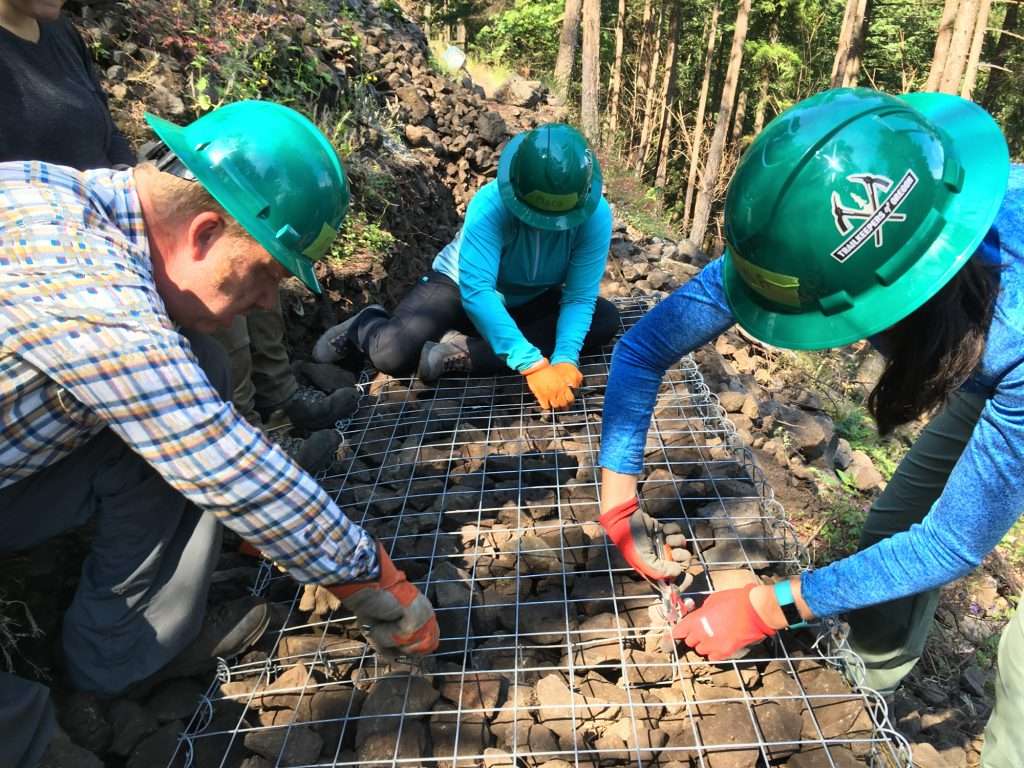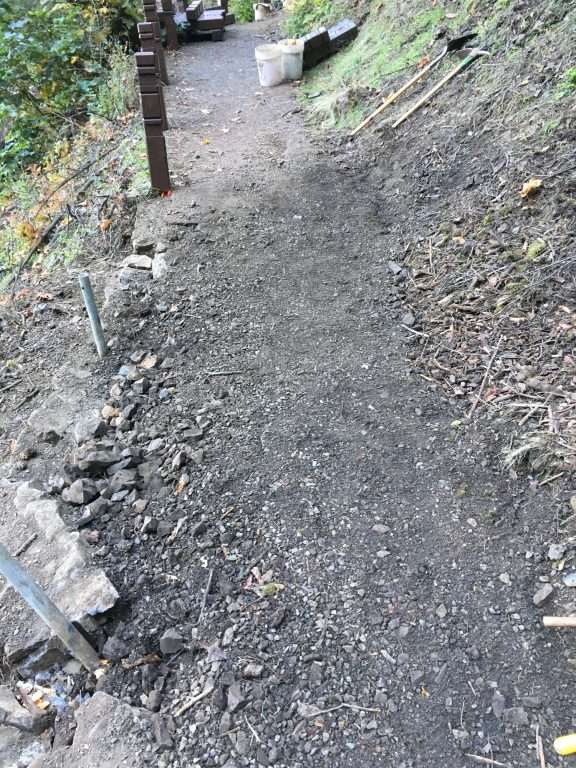By Steve Kruger, Executive Director, Trailkeepers of Oregon On October 27, trails professionals from nonprofits, outdoor recreation companies, and land management agencies came together in Bend, Oregon, for TKO’s first crack at hosting an Oregon Trails Summit. Trails…
By Susan Schen, Crew Leader, Trailkeepers of Oregon
Have you ever been hiking along and found yourself walking on what seems to be a metal fence embedded in the surface of the trail? If you have, you’ve encountered a gabion! A gabion is a rectangular metal mesh cage filled with rocks, forming a giant brick, to support the trail surface on steep hillsides. It is often used in place of rock retaining walls or log cribbing due to its ease of construction and longevity. It is an especially handy structure on trails in the Columbia River Gorge, where loose rocks and steep slopes abound. In a basic installation, a shelf or trench is excavated, and then the wire cage is assembled, placed, filled with rocks, closed, and covered with the soil that forms the trail surface.
![A man in a hard hat, with arms outstretched, standing on a rock-filled wire cage on a steep hillside.]](https://trailkeepersoforegon.org/wp-content/uploads/2019/07/schen-gabions-1-atop-768x768.jpg)
A TKO volunteer stands atop gabions ready to be covered with small rocks and soil on Return Trail #442 between Multnomah and Wahkeena falls. (Photo by Susan Schen)
A gabion installation starts with excavation of the shelf or trench. It’s usually dug four to six inches deeper than the height of the gabion to allow for the rocks and soil that will cover it and form the trail surface (ideally, hikers never see the gabion—an exposed metal cage is a sign of trail wear or erosion). The bottom of the excavation should also slope a few degrees inward (this angle is also known as the batter) so that the filled gabion leans into the hillside, reducing the risk of its sliding out of place.

TKO volunteers stand in a freshly dug gabion trench on Wahkeena Trail #420 (Photo by Susan Schen)
After excavation is complete (or while the trench is being dug), the wire cage is assembled. Several iterations of test-fitting are often necessary to assure proper depth and batter. Once the cage is properly fit, the process of filling it with rocks can begin. Large rocks are placed first in the corners. Then large flat rocks are put on the outside face to prevent smaller rocks inside from falling out through the holes in the mesh. As the cage is filled, wire ties are often installed at the front corners and from the rear to the front of the cage to reinforce the structure and prevent the outside face from bulging outward.

This gabion on the Return Trail is nearly full. (Photo by Susan Schen)
Once the cage is completely full of rocks, the top is wired shut and the gabion is buried. Ideally, with vegetation growing on its downhill side, the buried gabion is never noticed by hikers. The gabion will last as long as the mesh holds the rocks together, which, when galvanized or stainless steel wire is used, should be several decades.

TKO volunteers use pliers and short lengths of wire to tie the top of the gabion shut. (Photo by Susan Schen)
Gabions were used recently to reinforce the switchbacks by Wiesendanger Falls on Larch Mountain Trail #441—see if you can spot signs of them next time you hike that way!

A gabion is often undetectable, as illustrated by this recent installation just past the Benson Bridge at Multnomah Falls on the Larch Mountain Trail. (Photo by Susan Schen)
Susan Schen: susan.schen@trailkeepersoforegon.com

